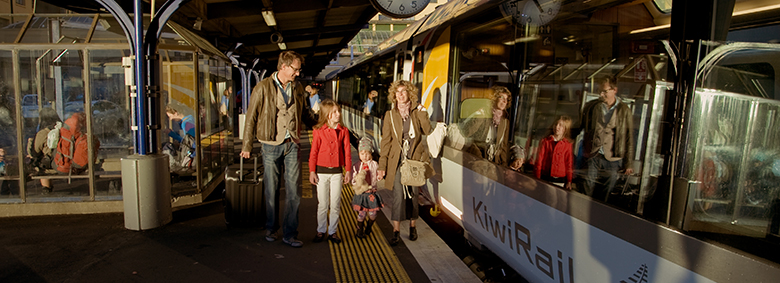Being a smart investor in the national transport system requires knowing what you’re trying to achieve and how to assess and deliver the best mix of options

The NZ Transport Agency carries out a wide range of activities to achieve its purpose of creating transport solutions for a thriving New Zealand. One of our biggest programmes of activities involves planning for, investing in, influencing, developing and monitoring the land transport system to ensure it’s effective, efficient, safe and responsible, and resilient. To do this successfully, the Transport Agency works with a wide range of partners, stakeholders, and customers.
The National Land Transport Fund (NLTF) is the government's main contribution to funding the land transport activities approved in the National Land Transport Programme (NLTP). How, where, when and in what the Transport Agency invests the NLTF is influenced by a number of factors. Desired transport outcomes, identified as impacts in our Statement of Intent, are derived from the Government Policy Statement (GPS) on Land Transport Funding.
Co-investing with others
The Transport Agency is not the only investor in the country’s transport system. KiwiRail, local government partners, industry and others also plan and deliver transport solutions across the transport system. Third parties, such as land developers, often receive benefit from transport investment so they also invest in transport system improvements, eg contribute to building infrastructure to support a new development.
How the Transport Agency makes investment decisions
But before any new investment is made, the Transport Agency works with partners to develop business cases to make sure they identify the right issue(s) supported by evidence, and from there promote the right and appropriately scaled solution. Selecting the right interventions requires taking a one-network approach, working with partners across networks and modes.
Firstly the Transport Agency considers if the business case has evidence to show how the proposal aligns with integrated land use and expected transport growth patterns. The second step is to be clear on the issues, if any, arising from this and check that the proposal has investigated a range of opportunities to manage traffic growth including getting the most out of the existing network. Once all those steps have been successfully proven, investment in new infrastructure can be considered.
The Transport Agency’s Investment and Revenue Assessment Framework (IRAF) ensures investment decisions are consistent and optimal. The IRAF sets out three factors that are used to assess investment proposals:
In other words, the framework ensures the Transport Agency invests in the right projects that will deliver the right outcomes, at the right time, and ensures projects are delivered in the right way and for the best price.
Ongoing development of economic evaluation processes
The agency’s economic evaluation processes have recently been updated to ensure they continue to reflect international best practice. This ongoing development of our practice is important so we can be confident we’re providing the government and all New Zealanders the best outcomes for their investment.
Recent changes include revising the discount rate to 6%, along with extending the evaluation period from 30 to 40 years. Additional wider economic benefits (WEBs) have also been included. WEBs account for real and tangible benefits that are additional to conventional transport benefits such as costs savings from reduced journey times, vehicle operating costs and safety improvements. For example, WEBs include the productive benefits that can arise from more efficient business and personal interactions, benefits that can arise when more people enter the labour force and move to more productive jobs. WEBs are particularly relevant when assessing very large and complex projects in and between major urban areas.
Investing in multi-modal transport solutions
NLTP and local/regional investment plans also need to be developed and optimised in the context of a whole-of-transport-system approach. The Transport Agency reviews regional investments against national perspectives in terms of the relative size, scale and interdependencies across multiple network issues and opportunities.
Where synergies exist, the Transport Agency invests in integrated packages of interventions. Packages often contain investments in a number of activity classes, eg roading improvements combined with new public transport infrastructure, improved public transport services and provisions for pedestrians and cyclists as well as speed management, education and regulation.
Sometimes, individual elements in a transport package can be of comparatively low priority for investment. But without each element, the effectiveness and value-for-money of the overall package could be compromised. Therefore, the Transport Agency evaluates the efficiency of the package as a whole by understanding the cumulative benefits that could be achieved and calculating a single BCR for the combined package of activities. The preferred form, inclusion and timing of individual elements are then evaluated using incremental analysis of the range of available options to optimise the delivery of the overall package.
This approach has resulted in the delivery of some large packages of projects that are made up of several smaller ones – some with relatively low BCRs. And far from being a mistake or lacking in economic rigour, this approach illustrates the shift in transport investment to facilitate the key priorities identified in the GPS, taking a whole-of-transport-system view and addressing all components that make up the major constraints in the transport system. Without this system-focused approach, a piece meal approach would result, and New Zealand’s transport system would potentially under-perform in terms of the government’s priorities.
Auditing the NLTP
The Transport Agency also audits investments made through the NLTP to check they delivered the promised customer benefits and that appropriate systems were followed. The current audit programme includes technical, procedural, post-implementation, road infrastructure safety, and audits on particular topics, as well as determining the investment’s cumulative impact on the journey.
More information is available here(external link).